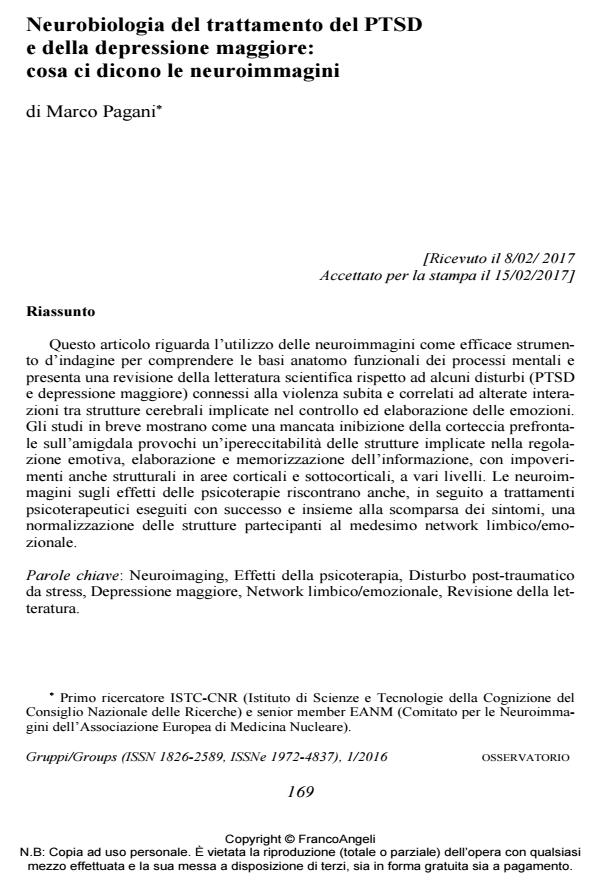Neurobiologia del trattamento del PTSD e della depressione maggiore: cosa ci dicono le neuroimmagini
Journal title GRUPPI
Author/s Marco Pagani
Publishing Year 2017 Issue 2016/1
Language Italian Pages 9 P. 169-177 File size 158 KB
DOI 10.3280/GRU2016-001014
DOI is like a bar code for intellectual property: to have more infomation
click here
Below, you can see the article first page
If you want to buy this article in PDF format, you can do it, following the instructions to buy download credits

FrancoAngeli is member of Publishers International Linking Association, Inc (PILA), a not-for-profit association which run the CrossRef service enabling links to and from online scholarly content.
Neuroimaging is an efficient tool to investigate the anatomical and functional basis of mental processes. A revision of the scientific literature regarding conditions (PTSD and major depression) connected to violence and traumatic experiences is presented, exploring the connection between these syndromes and a modified interaction between cerebral structures implicated in the control and processing of emotions. Research shows how a missing inhibition of the prefrontal cortex on the amygdala leads to hyperexcitability of the structures involved in emotional regulation, elaboration and memorization of information and with impoverishments, some of which structural, in cortical and subcortical areas at multiple levels. Neu-roimaging on the effects of psychotherapy show, in successful psychotherapeutic treatments resulting in the disappearance of the symptoms, a normalisation of the structures regarding the same limbic emotional network. Neuroimaging is an efficient tool to investigate the anatomical and functional basis of mental processes. A revision of the scientific literature regarding conditions (PTSD and major depression) connected to violence and traumatic experiences is presented, exploring the connection between these syndromes and a modified interaction between cerebral structures implicated in the control and processing of emotions. Research shows how a missing inhibition of the prefrontal cortex on the amygdala leads to hyperexcitability of the structures involved in emotional regula-tion, elaboration and memorization of information and with impoverishments, some of which structural, in cortical and subcortical areas at multiple levels. Neuroimaging on the effects of psychotherapy show, in successful psychotherapeutic treatments resulting in the disappearance of the symptoms, a normalisation of the structures regarding the same limbic emotional network.
Keywords: Neuroimaging, Psychotherapy effects, Posttraumatic stress disorder (PTSD), Major depression, Limbic emotional network, Literature review
Marco Pagani, Neurobiologia del trattamento del PTSD e della depressione maggiore: cosa ci dicono le neuroimmagini in "GRUPPI" 1/2016, pp 169-177, DOI: 10.3280/GRU2016-001014